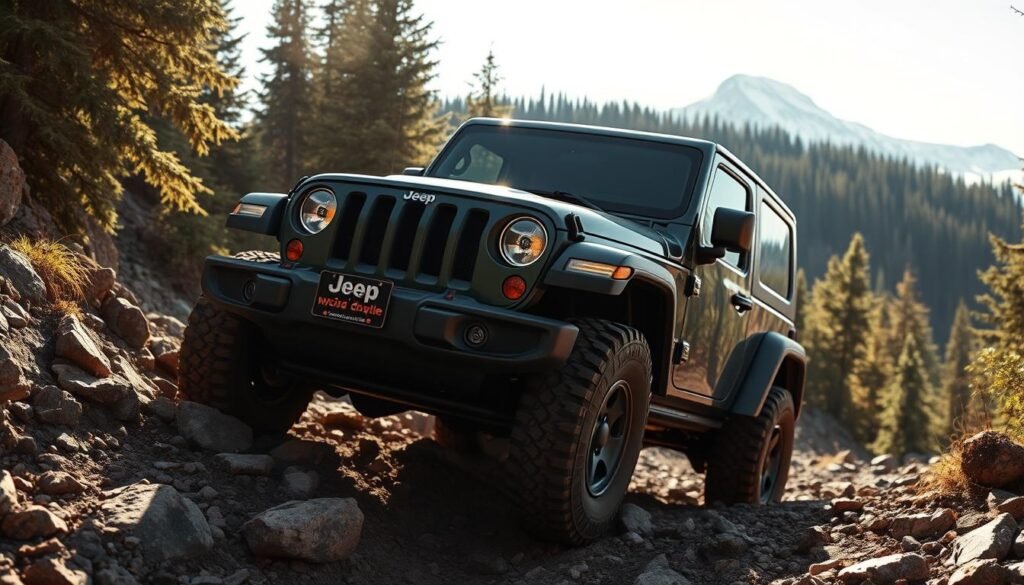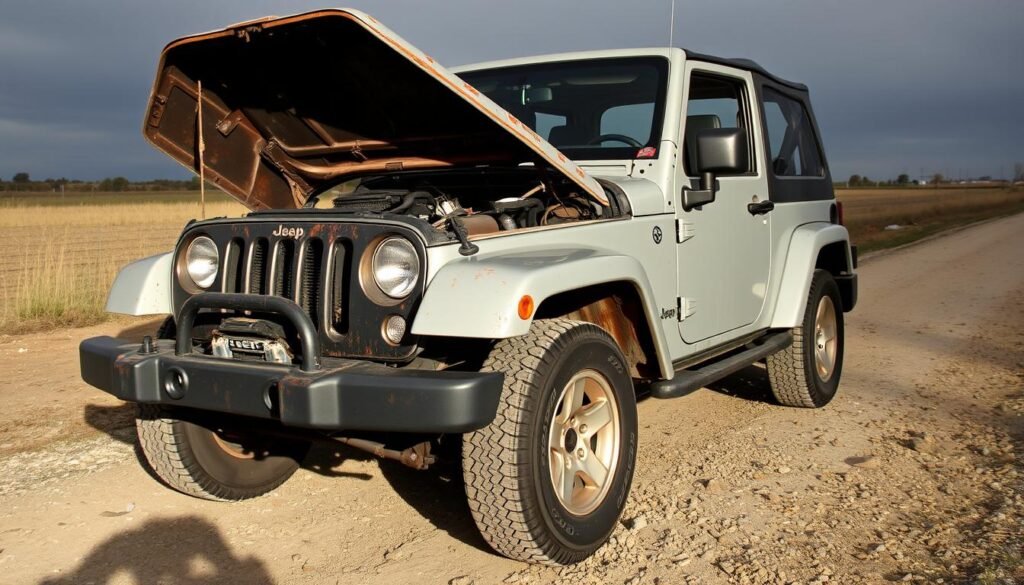A 2021 Jeep Gladiator caught fire at just 2,536 miles, leaving the owner with a total loss. This incident shows how important it is to know about Jeep Gladiator problems. The mid-size truck has big reliability issues that need attention.
Consumer Reports says the Gladiator is one of 60 used vehicles to avoid. This raises big concerns about its long-term performance. The truck has had many safety recalls, mainly for issues with the manual transmission, clutch, and drive system.
People thinking of buying or already owning a Jeep Gladiator need to know about common problems. These issues can affect safety and reliability. Engine troubles and electrical system failures are just a few examples.
Jeep Gladiator problems range from serious safety issues to ongoing mechanical defects. Knowing about these problems can help owners make better choices. It can also help avoid risks with this mid-size truck.
Common Jeep Gladiator Problems
Jeep Gladiator owners face many challenges. These issues are important for both current and future owners to know. Over 300,000 vehicles have been surveyed, showing several major problems across different years.
The Jeep Gladiator’s reliability has several concerns. Knowing these issues helps owners plan for maintenance and repairs.
Engine and Powertrain Concerns
Engine problems are a big issue for Jeep Gladiator owners. The main engine issues include:
- Major engine rebuilds or replacements
- Timing chain complications
- Cylinder head failures
- Unexpected oil and fuel leaks
Electrical System Failures
Electrical failures can be very frustrating. Key electrical problems include:
- Alternator malfunctions
- Starter system failures
- Cruise control inconsistencies
- Warning light irregularities
Structural Integrity Issues
Structural concerns can affect the vehicle’s performance and safety. Owners have reported several structural problems:
- Wind noise and seal deterioration
- Window and lock mechanism failures
- Body hardware defects
- Potential paint and trim durability issues
Proactive maintenance and thorough pre-purchase inspections can help mitigate these common Jeep Gladiator problems. Despite these issues, many owners love the vehicle’s design and off-road abilities.
Engine Performance and Reliability Concerns
The Jeep Gladiator faces engine performance challenges that buyers need to think about. Reliability concerns are key to its long-term use, mainly with its engine choices.
The Gladiator has two main engine types that affect its performance:
- 3.6L Pentastar V6 Engine
- 285 horsepower
- 260 lb-ft of torque
- Potential for over 200,000 miles with proper maintenance
- 3.0L EcoDiesel V6 Engine
- 260 horsepower
- 442 lb-ft of torque
- Enhanced towing capabilities
Engine problems can show up in different ways, like Jeep Gladiator problems such as:
- Minor oil leaks
- Occasional engine knocking
- Electronic system glitches
| Model Year | Reliability Rating | Key Performance Notes |
|---|---|---|
| 2020 | Lower Reliability | Initial production challenges |
| 2022-2024 | Improved Reliability | Enhanced off-road capabilities |
Regular maintenance is key to avoiding engine issues. Regular checks, timely oil changes, and fixing small problems early can help the engine last longer.
Transmission Issues and Drive System Failures
Jeep Gladiator owners often face big transmission problems. These can make driving hard and unsafe. They can be small annoyances or big failures needing lots of fixes.
Jeep Gladiators have many symptoms of transmission trouble. These signs need quick action to keep drivers safe.
Major Transmission Problems
Jeep Gladiators have serious transmission issues. These include:
- Gear selector and linkage malfunctions
- Transmission computer failures
- Sensor or solenoid complications
- Rough shifting experiences
- Transmission fluid leaks
The worst problems can make the system fail completely. This means big, expensive repairs.
Drive System Component Failures
Drive system failures in Jeep Gladiators are big problems. They can make the vehicle less reliable and less safe.
| Component | Common Issues | Potential Consequences |
|---|---|---|
| Clutch System | Overheating risk | Potential fire hazard |
| Driveshaft | Assembly errors | Reduced vehicle stability |
| Pressure Plate | Fracturing risk | Critical system failure |
Transfer Case Complications
Transfer case problems are a big worry for Jeep Gladiator owners. Specialized diagnostic tools are needed to fix these complex issues.
Regular checks and maintenance can stop big failures. Owners should watch for warning signs and fix transmission problems fast to avoid expensive fixes.
Electrical System and Battery Complications

Jeep Gladiator owners often face tough electrical system problems. These issues can really affect how well the vehicle runs. They range from battery troubles to complex system failures that need expert help.
The most common electrical problems with Jeep Gladiators include:
- Alternator malfunctions
- Starter system failures
- Battery cable deterioration
- Electronic ignition system glitches
- Spark plug and wire degradation
Battery issues can show up in different ways. Owners say they experience unexpected battery drain, trouble starting the vehicle, and occasional electrical system failures. These problems often come from factory defects or parts wearing out too soon.
“Electrical problems can transform a reliable truck into an unpredictable machine overnight.” – Automotive Expert
Studies show electric and hybrid cars face more electrical issues than traditional gas engines. Jeep Gladiator models have electrical system problems that hurt their reliability. They rank 26th in overall vehicle dependability.
Regular maintenance is key. Keeping up with electrical system checks, battery health, and fixing issues early can prevent big problems and costly fixes.
Suspension and Steering System Problems
Jeep Gladiator owners often face tough suspension issues. These problems can hurt the vehicle’s performance and safety. The suspension is key for smooth handling and comfort.
Many Jeep Gladiator owners have reported suspension and steering system problems. These issues can be serious and affect the driving experience.
Ball Joint and Tie Rod Issues
Ball joints and tie rods are vital for the Jeep Gladiator’s suspension. Owners have found several major problems:
- Premature ball joint wear
- Excessive play in tie rod ends
- Rapid deterioration under challenging driving conditions
Alignment and Wheel Bearing Concerns
Steering system problems often come from alignment and wheel bearing issues. Signs include uneven tire wear and the vehicle pulling to one side.
| Alignment Issue | Typical Cost | Recommended Frequency |
|---|---|---|
| Standard Alignment | $60 – $150 | Every 5,000-10,000 miles |
| Wheel Bearing Replacement | $200 – $400 | As needed, based on wear |
Power Steering Failures
Power steering problems can be a big challenge for Jeep Gladiator drivers. Steering system problems include:
- Fluid leaks in steering components
- Pump failures
- Reduced steering responsiveness
Regular maintenance and quick action on suspension issues can help Jeep Gladiator owners. It can prevent safety risks and make the vehicle last longer.
Interior and Exterior Quality Issues
Jeep Gladiator owners have shared many quality concerns. These issues affect the vehicle’s performance and looks. The Gladiator’s interior and exterior quality range from small cosmetic issues to big structural problems.

- Paint and Finish Defects
- Premature paint fading
- Chalking and peeling
- Rust development on exterior panels
- Body Hardware Challenges
- Window seal integrity issues
- Loose door latches and locks
- Sunroof and convertible top malfunctions
Interior quality issues affect the driving experience. Trim parts often seem loose or poorly fitted. This raises long-term durability concerns.
The center touchscreen sometimes goes black. Seat controls and power mechanisms may not work consistently.
Exterior quality concerns go beyond looks. Owners face wind noise, water sealing issues, and structural vulnerabilities. The Jeep Gladiator’s rugged design is appealing but introduces quality challenges.
Climate Control and Cooling System Defects
Jeep Gladiator owners often face tough climate control and cooling system issues. These problems can really affect how well your vehicle works and how comfortable it is. The Jeep Gladiator’s climate and cooling systems need special care and regular upkeep.
It’s important to know about common climate control and cooling system problems. These issues can make your vehicle less reliable.
AC System Failures
AC system failures in the Jeep Gladiator can happen for a few main reasons:
- Low refrigerant levels
- Compressor malfunctions
- Clogged cabin air filters
- Dirty condenser or evaporator coils
Refrigerant leaks are a big worry. Most AC systems lose refrigerant over time. It’s a good idea to check the system every few years to keep it working well.
Heating System Problems
Heating system issues can come from different sources, like:
- Faulty blend door actuators
- Electrical control module failures
- Inconsistent temperature distribution
Coolant Leaks and Overheating
Cooling system problems can harm your Jeep Gladiator’s engine. Key issues include:
| Problem | Potential Cause | Recommended Action |
|---|---|---|
| Overheating | Low coolant levels | Immediate system inspection |
| Coolant Leaks | Cracked hoses/gaskets | Professional diagnostic |
| Temperature Fluctuations | Defective thermostat | Component replacement |
Regular maintenance and system checks can stop most climate control and cooling system problems. This keeps your Jeep Gladiator running smoothly and reliably.
Safety and Brake System Complications
Jeep Gladiator brake system problems can be very dangerous. The National Highway Traffic Safety Administration has found big issues with brake performance. Drivers have reported their vehicles pulling to one side when braking, showing serious brake problems.
The brake warning light is a big warning sign. If ignored, it can lead to unsafe driving. In New Jersey, cars must pass tough brake tests, stopping in just 30 feet from 20 mph. This is hard for stock brakes, even more so with bigger tires.
Brake safety is more than just replacing pads. ABS problems have been reported soon after buying a Jeep Gladiator. Drivers need to watch for warning lights and unusual brake actions. Regular checks by professionals can help avoid serious brake failures.
Regular maintenance is key to avoiding brake issues. Getting your Jeep checked often, fixing warning lights quickly, and knowing your brake needs can help. This way, you can stay safe on the road.
FAQ
What are the most common engine problems in the Jeep Gladiator?
Jeep Gladiator owners often face engine knocking, oil leaks, and major repairs like engine rebuilds. Some models have oil consumption and misfires, mainly in the 3.6L V6 engine. Regular maintenance and early detection can prevent serious engine issues.
How reliable is the Jeep Gladiator’s transmission?
The Gladiator’s transmission faces challenges, like issues with the 8-speed automatic. Owners report shifting problems, gear hesitation, and transfer case issues. Following the manufacturer’s maintenance schedule and addressing early signs is key.
What electrical system problems should I be aware of?
Common electrical issues include battery drain, alternator failures, and starter problems. Some owners face unexpected shutdowns, battery connection issues, and sensor malfunctions. Regular battery checks and diagnostics can prevent bigger problems.
Are there known suspension issues with the Jeep Gladiator?
The Gladiator faces suspension challenges like ball joint wear, tie rod problems, and alignment issues. Owners report premature ball joint wear and steering failures. Regular inspections and alignment checks can help avoid these problems.
What are the most frequent climate control problems?
Owners report AC system failures, inconsistent heating, and coolant leaks. Some models have reduced cooling or heating malfunctions. Regular maintenance and prompt attention to temperature control issues can prevent bigger problems.
How do brake system issues affect the Jeep Gladiator?
Some owners face premature brake wear, ABS malfunctions, and brake inconsistencies. Regular inspections, timely pad replacements, and brake fluid maintenance ensure safety and performance.
What interior and exterior quality concerns should I know about?
Owners report paint quality issues, trim problems, and body hardware challenges. Some models wear interiors quickly, mainly in high-use areas. Proper care and maintenance can preserve the vehicle’s look and function.
Is the Jeep Gladiator prone to structural integrity problems?
While robust, some owners note body panel, frame connection, and long-term structural integrity issues. Regular inspections, after off-road use or in harsh conditions, can identify and address structural concerns early.


